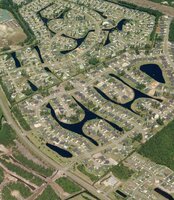- England
- Scotland
- France
- Holland
- Germany
- Italy
- Spain
- Portugal
- USA
- China
- Japan
- India
- Iran
- Advice
- Gardens
- England
- Scotland
- France
- Holland
- Germany
- Italy
- Spain
- Portugal
- USA
- China
- Japan
- India
- Iran
- Advice
- Garden Tours
Book: Landscape Planning and Environmental Impact Design: from EIA to EID
Chapter: Chapter 11 Urbanisation and growth management
New settlements require land. Yet the capital cost is high and the payback period is long. Public developers are driven to high taxation; private developers are driven to bankruptcy; only the speculators reap profits. The best solution is a blend of public with private ownership. Land should be taken into public ownership, at 25% above existing use prices, provided with a public infrastructure and then sold to private individuals and public companies as urbanisation proceeds. The British New Towns Act of 1946 used this principle, but too much land was kept in public ownership and the parcels of land released for private development were too large. In America the Housing and Urban Development Acts of 1968 and 1970 offered financial support to large private developers so that they could create planned communities. Loans were guaranteed, under Title VII of the Act, and supplementary grants made available for water, sewerage, open space provision and beautification. Front-end investment of this type is very important in new town development, but land is more important than money. In Britain, the parcels of land released for development were known as 'housing estates' or 'industrial estates', were allocated to individual developers and their design teams. In the United States, the system is known as subdivision. These policies have a profound effect on urban form [Fig 1.14]. It produced large areas dominated by units of housing or industry, in uniform and often eccentric architectural styles. Patrick Nuttgens described the 'monumental repetition of units' in mass housing as 'the most serious intellectual and moral mistake architects have ever made' (Nuttgens 1981). The aesthetic reason for giving 'housing estates' to different design teams was to create architectural variety, as in unplanned towns, combined with stylistic unity, as in the planned aristocratic quarters of eighteenth century towns. The policy failed because, at the town scale, the 'housing estates' were visually unrelated, and within each estate the units were similar but unconnected. Nor were houses placed to make good outdoor spaces. Roads, gardens and communal green spaces were badly designed. There was too much uniformity within estates and too much disunity between estates. Typically, they are of similar-sized dwellings, because of zoning regulations, but with a hotch-potch of architectural styles. One may or may not prefer the visual effect. It is monoculture with all the associated diseconomies and disecologies. There were also two economic reasons for parcelling land into housing estates. It was thought that building a large number of housing units in one place and at one time would produce economies of scale. This has not been proved (Lynch & Hack 1984: 283) and studies of other industries have not revealed a linear relationship between the size of an enterprise and unit production costs. The arguments which Schumacher produced to support his 'small is beautiful' hypothesis may apply to house construction (Schumacher 1973). A second economic justification for housing estates concerns cash flow. It is thought that money spent on estate roads and services should produce an early return. This consideration is valid but goes against the principle of investing for the longï¾term benefit of the community. Public authorities, and large private developers, should justify their involvement in private housing by a willingness to look ahead and to make frontï¾end investments in roads and other infrastructure projects. Land should not be developed in large blocks for administrative convenience. The concept of a street can be extended to provide an alternative to housing and industrial estates, as discussed in the previous chapter (page...). Roads, footpaths, cycleways and paths should be laid out before any buildings are designed. This enables land uses, and buildings of different ages, to be intermixed. Developers can come forward with proposals for single houses, groups of houses, workshops, offices, bars, schools, shops and other uses. Some of Britain's new towns have so much surplus road space, pathspace [Fig 11.24] and parkland that land could be found to implement the policy even now. Nan Fairbrother wrote that 'the early New Towns, for all their merits, would feel far better places to live in if one town were superimposed on another and shuffled together to fill up the gaps' (Fairbrother 1970: 325). Some gaps are already being filled on 'open plan' estates at Peterlee, and elsewhere. No plans are immutable and it is time to produce new landscape plans for the 'new' towns of the past 50 years.
